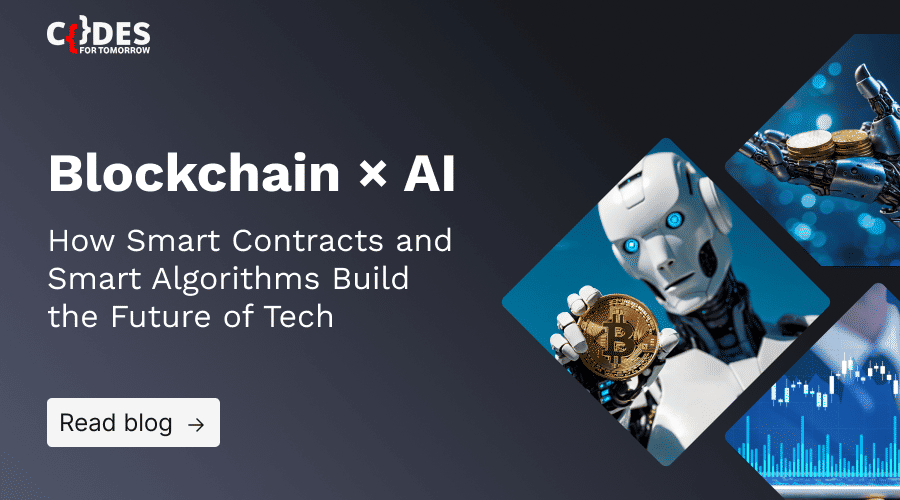Blockchain x AI: How Smart Contracts and Algorithms Are Building the Future
Blockchain and AI are two of the most disruptive forces in today's tech landscape. Individually, they've transformed industries—AI by driving intelligent automation, and blockchain by introducing decentralized trust. But when combined, these technologies do more than enhance each other; they lay the groundwork for transparent, secure, and autonomous systems that could shape the next generation of digital products.
In this article, we'll explore how blockchain and AI work together, why this combination matters, and real-world examples of decentralized, intelligent applications.
Why AI Needs Blockchain
AI systems today are typically centralized. You build models, deploy them on servers using frameworks like Flask or FastAPI, and handle everything from data collection to monetization. But this centralized approach comes with problems:
- Data ownership and control: Who really owns or controls the data your AI relies on? Can its authenticity be verified?
- Opaque outputs: Most AI systems can't prove that a specific model version produced a particular output. This is risky for critical use cases like credit scoring, healthcare, or compliance.
- Monetization headaches: Developers often build custom billing systems from scratch, using services like Stripe. These systems are prone to fraud, logic errors, and are expensive to maintain.
Blockchain technology addresses these issues by adding a layer of trust, transparency, and automation through smart contracts and immutable ledgers.
How Blockchain Complements AI
Here's how blockchain and AI together form a powerful stack:
- Decentralized verification: Blockchain allows multiple parties to verify transactions and data without relying on a single authority. This means AI systems can prove their outputs cryptographically.
- Immutable data trails: Blockchain ensures data and model changes are permanently recorded. This is crucial for auditing AI training data, model updates, or inference logs.
- Smart contracts for automation: Payments, access control, and licensing can all be enforced by smart contracts, removing the need for centralized billing logic.
- Distributed trust: Instead of trusting a single AI provider, users trust the blockchain network's consensus. This is especially important for regulated or high-stakes applications.
Use Case 1: Smart Contract-Driven AI Subscriptions
Traditional AI SaaS platforms rely on backend billing setups. You build integrations with Stripe or Razorpay, manage user accounts, and keep payment data secure — all while preventing fraud.
Blockchain flips this model. On Ethereum or Polygon, you can use smart contracts to handle subscriptions:
- A user connects their wallet and pays in stablecoins (like USDC).
- The smart contract records the payment and issues a time-bound access token or NFT.
- Your AI backend simply checks the user's wallet for a valid token.
No centralized accounts, no manual billing reconciliation, and every transaction is transparent and tamper-proof. This is a major step forward for decentralized AI monetization, reducing operational overhead while enhancing security and trust.
Use Case 2: Verifiable AI Outputs
Imagine using an AI model for legal document analysis, medical diagnosis, or a DAO voting system. How can you prove the output wasn't manipulated?
With blockchain:
- Each version of your AI model is hashed, and the hash is stored on-chain.
- When the model generates an output, it also creates a Merkle proof linking that output to the specific on-chain model version.
- Anyone can verify the result independently by checking the cryptographic proof against the blockchain.
This moves AI from a "trust us" model to a "prove it" model — critical for industries that demand compliance and accountability.
Use Case 3: Decentralized AI Data Marketplaces
AI thrives on data. But today's data markets are controlled by centralized brokers, often with unclear ownership or licensing.
Blockchain enables decentralized data marketplaces:
- Data contributors upload datasets to decentralized storage like IPFS or Arweave.
- They sign the data with their wallet, tying ownership to a cryptographic identity.
- Consumers license the data through smart contracts, which automatically route payments to the contributors.
This means every dataset's origin is traceable, licensing is transparent, and small contributors get fairly compensated, unlocking a global, open AI data economy.
Real-World Examples of Blockchain and AI Integration
Plenty of startups are already leveraging blockchain and AI together. Here are some inspiring examples:
- Alethea AI: Builds GPT-powered avatars tokenized as NFTs. These can be bought, trained, and traded on-chain, monetizing through marketplace sales and programmable interactions.
- Ocean Protocol: Runs a decentralized marketplace for tokenized datasets. Data owners earn from access fees while smart contracts enforce licensing.
- Altered State Machine: Sells AI agents (like digital soccer players) as NFTs. Owners can upgrade agents using tokens, creating an evolving, AI-driven economy.
- ChainML: Coordinates decentralized computing for AI inference tasks, using staking and protocol fees to incentivize nodes.
- Sentinel: Combines decentralized VPN infrastructure with AI for threat detection, while blockchain handles billing and token rewards.
These projects prove blockchain and AI aren't just complementary — together, they're already enabling innovative, revenue-generating models.
A Vision: Build Your Own Blockchain x AI Platform
Say you want to build an AI tool that checks legal documents for compliance or plagiarism. Instead of a Web2 SaaS with private logs and credit card billing, your architecture could look like this:
- Smart contracts on Ethereum (or a layer-2 like Polygon): Handle payments and log document hashes for transparency.
- AI model on a serverless platform or Hugging Face Inference API: Runs the actual analysis.
- Frontend in React with MetaMask: Let users pay in stablecoins and sign transactions seamlessly.
- Optional decentralized storage (IPFS): Stores documents so anyone can retrieve them by content hash.
When a user pays, your smart contract logs the transaction and the document hash. Your AI returns results tied to this record, creating a transparent, verifiable process from payment to output.
Conclusion: The Future is Transparent and Trustless
Blockchain provides decentralized trust and tamper-proof records. AI offers intelligent analysis that adjusts to new information. Together, they create applications that are secure, self-funding, and cryptographically verifiable.
From smart contracts managing subscription payments to traceable AI outputs and open data marketplaces, the combination of these technologies is changing how we create and profit from digital systems.
As developers and founders, we are leading the way in creating decentralized, intelligent apps. These apps don't just predict or automate; they verify every step, build user trust, and open up entirely new business models.
Frequently Asked Question
Ans : Yes. Gas fees can make transactions costly. Public blockchains also mean data (or metadata) is permanently visible, which may raise privacy concerns. Also, bugs in smart contracts are hard to fix once deployed, so rigorous auditing is essential.
Ans : Secure bridging often uses signed wallet interactions and cryptographic proofs. For deeper integrations, use decentralized oracles or zk-proofs to validate AI outputs without exposing model internals.
Ans : Beyond typical smart contract exploits, AI-specific risks include adversarial input attacks, model inversion, or poisoned training data. Secure pipelines and on-chain auditability are essential.
Ans : It’s a blockchain-based system where data contributors upload datasets to decentralized storage (like IPFS), sign them cryptographically, and get paid automatically via smart contracts when consumers license or use that data. This enables transparent, fair data exchanges.
Ans : Projects like Alethea AI or Altered State Machine embed AI models into NFTs. Owners can train or upgrade these AI agents, and blockchain ensures their traits and version history are tracked and tradable, enabling programmable digital assets.







